Analysis of Obesity in Australia: Health Determinants and Nursing
VerifiedAdded on 2021/06/16
|12
|3567
|22
Essay
AI Summary
This essay provides a comprehensive analysis of the obesity epidemic in Australia, examining its prevalence, causes, and consequences. It delves into the social determinants of health, including poverty, education, and income, and how these factors contribute to the higher rates of obesity among certain populations. The essay explores the impact of discrimination and the code of conduct in nursing practice, highlighting health disparities within the Australian healthcare system, particularly for indigenous populations and those with low socioeconomic status. It also discusses the role of historical and political factors in shaping healthcare access and quality. Furthermore, the essay analyzes various models of healthcare services in Australia, such as primary care and community services, and health promotion and disease prevention, assessing how these models either support or hinder person-centered care and cultural safety in nursing practices. The analysis includes ethical considerations, nursing codes of conduct, and the importance of patient-centered care to address the obesity crisis effectively.
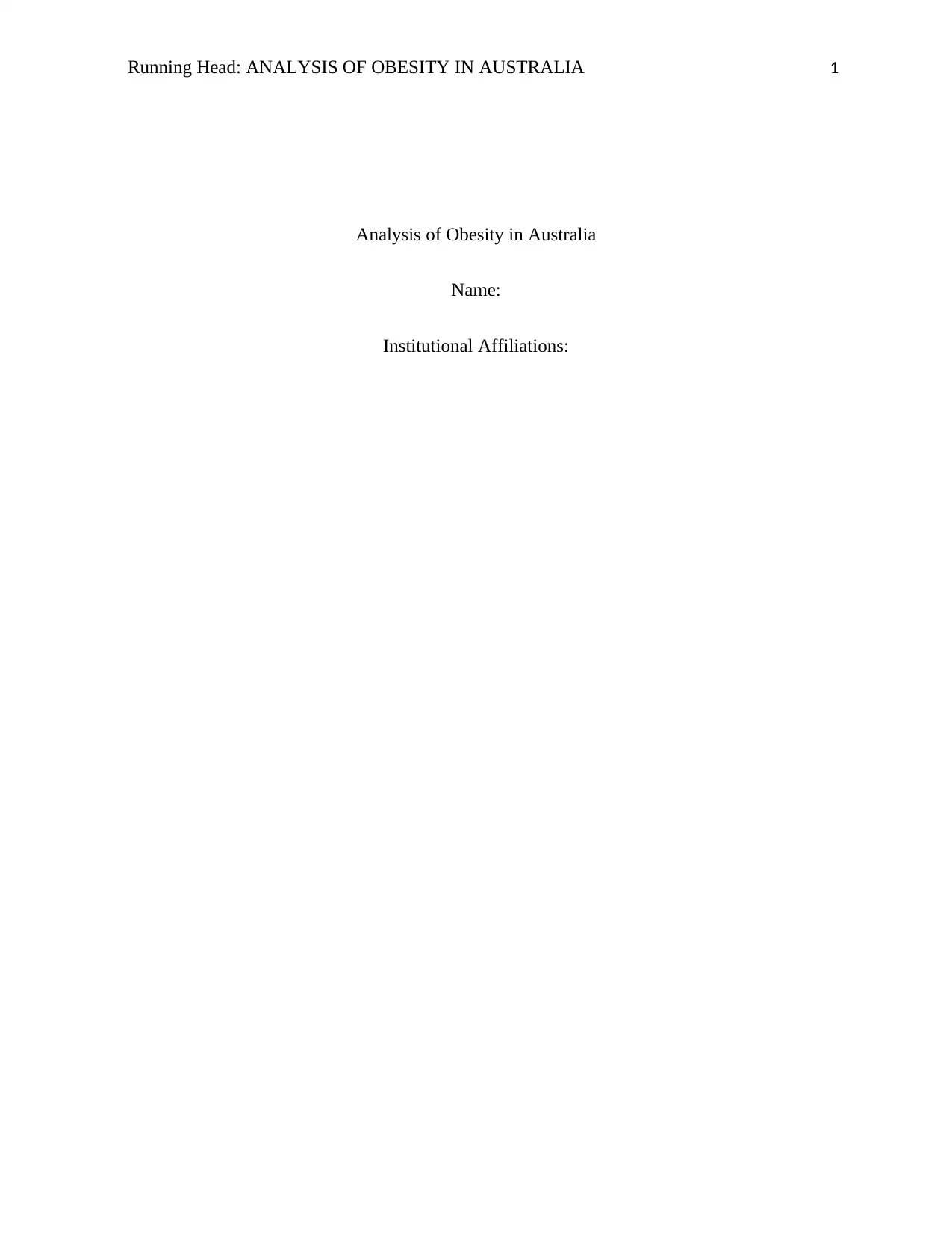
Running Head: ANALYSIS OF OBESITY IN AUSTRALIA 1
Analysis of Obesity in Australia
Name:
Institutional Affiliations:
Analysis of Obesity in Australia
Name:
Institutional Affiliations:
Paraphrase This Document
Need a fresh take? Get an instant paraphrase of this document with our AI Paraphraser
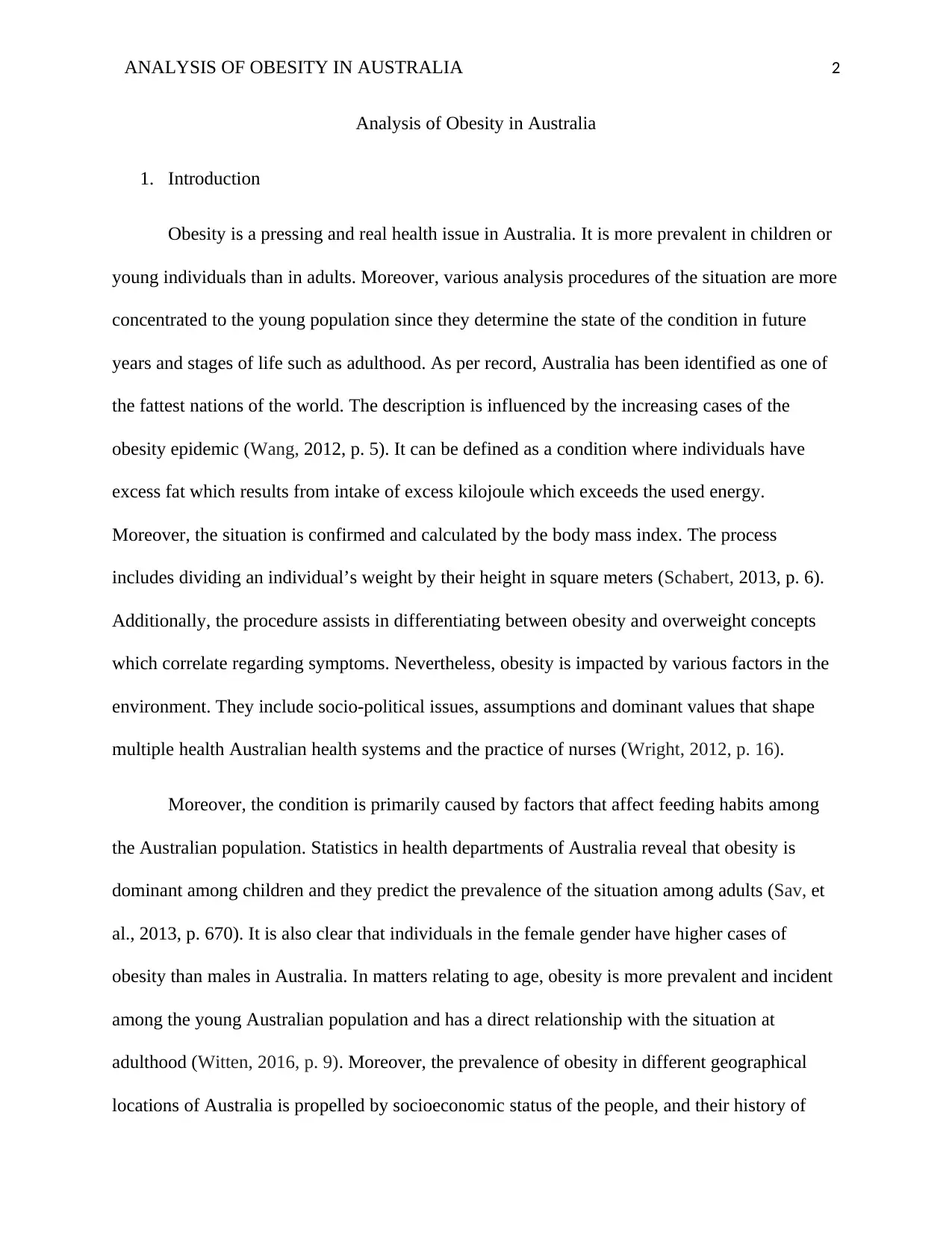
ANALYSIS OF OBESITY IN AUSTRALIA 2
Analysis of Obesity in Australia
1. Introduction
Obesity is a pressing and real health issue in Australia. It is more prevalent in children or
young individuals than in adults. Moreover, various analysis procedures of the situation are more
concentrated to the young population since they determine the state of the condition in future
years and stages of life such as adulthood. As per record, Australia has been identified as one of
the fattest nations of the world. The description is influenced by the increasing cases of the
obesity epidemic (Wang, 2012, p. 5). It can be defined as a condition where individuals have
excess fat which results from intake of excess kilojoule which exceeds the used energy.
Moreover, the situation is confirmed and calculated by the body mass index. The process
includes dividing an individual’s weight by their height in square meters (Schabert, 2013, p. 6).
Additionally, the procedure assists in differentiating between obesity and overweight concepts
which correlate regarding symptoms. Nevertheless, obesity is impacted by various factors in the
environment. They include socio-political issues, assumptions and dominant values that shape
multiple health Australian health systems and the practice of nurses (Wright, 2012, p. 16).
Moreover, the condition is primarily caused by factors that affect feeding habits among
the Australian population. Statistics in health departments of Australia reveal that obesity is
dominant among children and they predict the prevalence of the situation among adults (Sav, et
al., 2013, p. 670). It is also clear that individuals in the female gender have higher cases of
obesity than males in Australia. In matters relating to age, obesity is more prevalent and incident
among the young Australian population and has a direct relationship with the situation at
adulthood (Witten, 2016, p. 9). Moreover, the prevalence of obesity in different geographical
locations of Australia is propelled by socioeconomic status of the people, and their history of
Analysis of Obesity in Australia
1. Introduction
Obesity is a pressing and real health issue in Australia. It is more prevalent in children or
young individuals than in adults. Moreover, various analysis procedures of the situation are more
concentrated to the young population since they determine the state of the condition in future
years and stages of life such as adulthood. As per record, Australia has been identified as one of
the fattest nations of the world. The description is influenced by the increasing cases of the
obesity epidemic (Wang, 2012, p. 5). It can be defined as a condition where individuals have
excess fat which results from intake of excess kilojoule which exceeds the used energy.
Moreover, the situation is confirmed and calculated by the body mass index. The process
includes dividing an individual’s weight by their height in square meters (Schabert, 2013, p. 6).
Additionally, the procedure assists in differentiating between obesity and overweight concepts
which correlate regarding symptoms. Nevertheless, obesity is impacted by various factors in the
environment. They include socio-political issues, assumptions and dominant values that shape
multiple health Australian health systems and the practice of nurses (Wright, 2012, p. 16).
Moreover, the condition is primarily caused by factors that affect feeding habits among
the Australian population. Statistics in health departments of Australia reveal that obesity is
dominant among children and they predict the prevalence of the situation among adults (Sav, et
al., 2013, p. 670). It is also clear that individuals in the female gender have higher cases of
obesity than males in Australia. In matters relating to age, obesity is more prevalent and incident
among the young Australian population and has a direct relationship with the situation at
adulthood (Witten, 2016, p. 9). Moreover, the prevalence of obesity in different geographical
locations of Australia is propelled by socioeconomic status of the people, and their history of

ANALYSIS OF OBESITY IN AUSTRALIA 3
alcohol consumption and smoking. Therefore, this paper will analyze obesity and the socio-
political, historical, assumptions and dominant values that impact it in Australian nursing
practices.
2. Body
2.1 Social determinants of health
Various factors lead to the increased obesity epidemic in Australia. They include social
determinants of health that influence the health status of Australians as well as the quality of
healthcare services received by the affected individuals (Badland et al., 2013, p. 68). One of the
primary determinants of obesity prevalence in Australia is poverty. The latter affects the
socioeconomic aspects of individuals concerning education, income, food and geographic
distribution or locations. An analysis conducted on education qualifications among Australians
imply that most of the financially advantaged individuals have higher qualifications in education
such as masters, degrees, and diplomas. Moreover, the individuals have minimal chances of
being obese.
On the other hand, individuals that cannot afford quality education have lower
qualifications in education and high chances of being obese. Research conducted in 2004 to 2005
revealed that obesity infected twenty-one percent of individuals without non-school
qualifications (Mitrou et al., 2014, p. 281). Also, nineteen percent of individuals with lower
school qualifications due to poverty were obese. Correspondingly, the statistical figure indicated
that only thirteen percent of individuals with high qualifications and from financially stable
backgrounds suffered from obesity.
alcohol consumption and smoking. Therefore, this paper will analyze obesity and the socio-
political, historical, assumptions and dominant values that impact it in Australian nursing
practices.
2. Body
2.1 Social determinants of health
Various factors lead to the increased obesity epidemic in Australia. They include social
determinants of health that influence the health status of Australians as well as the quality of
healthcare services received by the affected individuals (Badland et al., 2013, p. 68). One of the
primary determinants of obesity prevalence in Australia is poverty. The latter affects the
socioeconomic aspects of individuals concerning education, income, food and geographic
distribution or locations. An analysis conducted on education qualifications among Australians
imply that most of the financially advantaged individuals have higher qualifications in education
such as masters, degrees, and diplomas. Moreover, the individuals have minimal chances of
being obese.
On the other hand, individuals that cannot afford quality education have lower
qualifications in education and high chances of being obese. Research conducted in 2004 to 2005
revealed that obesity infected twenty-one percent of individuals without non-school
qualifications (Mitrou et al., 2014, p. 281). Also, nineteen percent of individuals with lower
school qualifications due to poverty were obese. Correspondingly, the statistical figure indicated
that only thirteen percent of individuals with high qualifications and from financially stable
backgrounds suffered from obesity.
⊘ This is a preview!⊘
Do you want full access?
Subscribe today to unlock all pages.

Trusted by 1+ million students worldwide
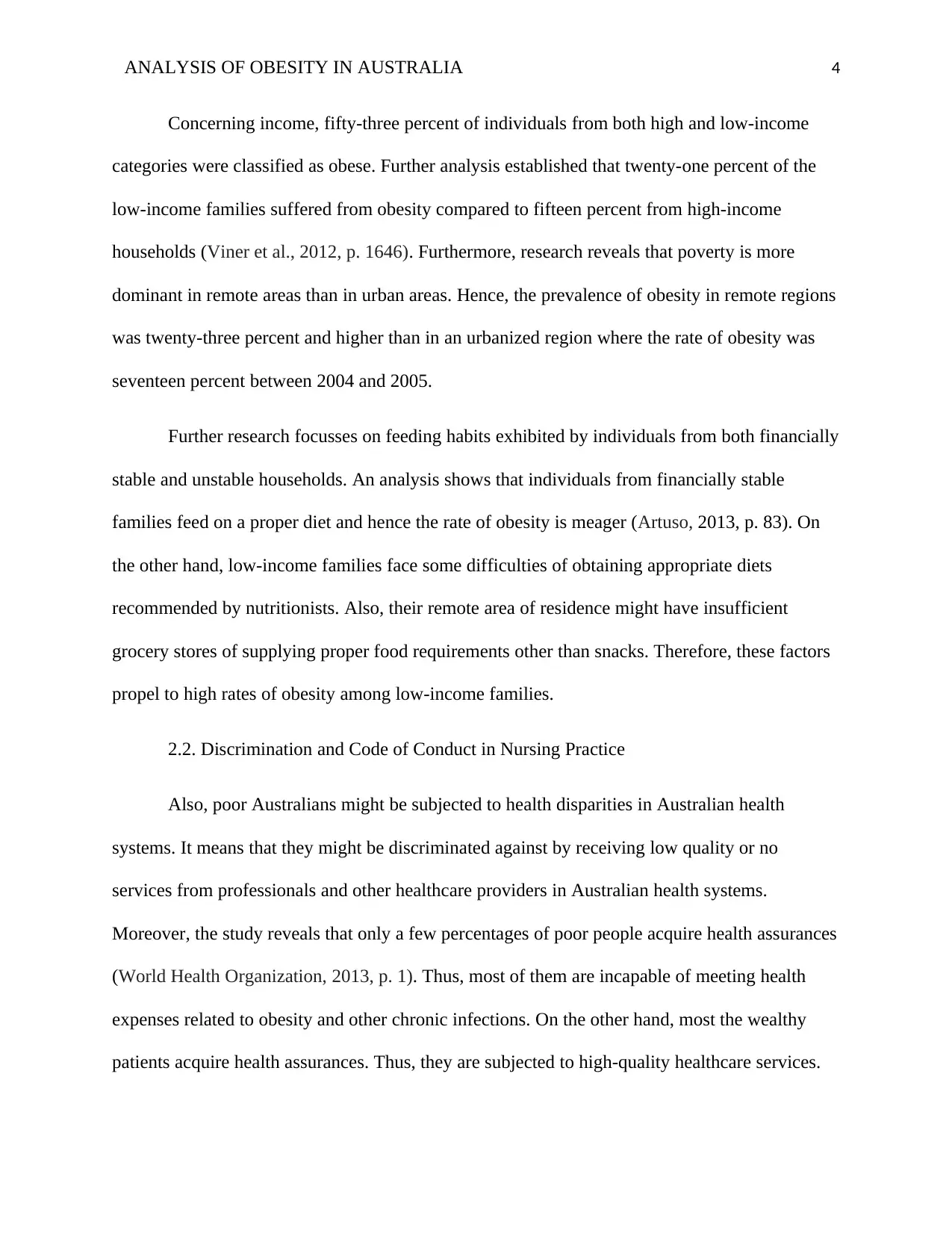
ANALYSIS OF OBESITY IN AUSTRALIA 4
Concerning income, fifty-three percent of individuals from both high and low-income
categories were classified as obese. Further analysis established that twenty-one percent of the
low-income families suffered from obesity compared to fifteen percent from high-income
households (Viner et al., 2012, p. 1646). Furthermore, research reveals that poverty is more
dominant in remote areas than in urban areas. Hence, the prevalence of obesity in remote regions
was twenty-three percent and higher than in an urbanized region where the rate of obesity was
seventeen percent between 2004 and 2005.
Further research focusses on feeding habits exhibited by individuals from both financially
stable and unstable households. An analysis shows that individuals from financially stable
families feed on a proper diet and hence the rate of obesity is meager (Artuso, 2013, p. 83). On
the other hand, low-income families face some difficulties of obtaining appropriate diets
recommended by nutritionists. Also, their remote area of residence might have insufficient
grocery stores of supplying proper food requirements other than snacks. Therefore, these factors
propel to high rates of obesity among low-income families.
2.2. Discrimination and Code of Conduct in Nursing Practice
Also, poor Australians might be subjected to health disparities in Australian health
systems. It means that they might be discriminated against by receiving low quality or no
services from professionals and other healthcare providers in Australian health systems.
Moreover, the study reveals that only a few percentages of poor people acquire health assurances
(World Health Organization, 2013, p. 1). Thus, most of them are incapable of meeting health
expenses related to obesity and other chronic infections. On the other hand, most the wealthy
patients acquire health assurances. Thus, they are subjected to high-quality healthcare services.
Concerning income, fifty-three percent of individuals from both high and low-income
categories were classified as obese. Further analysis established that twenty-one percent of the
low-income families suffered from obesity compared to fifteen percent from high-income
households (Viner et al., 2012, p. 1646). Furthermore, research reveals that poverty is more
dominant in remote areas than in urban areas. Hence, the prevalence of obesity in remote regions
was twenty-three percent and higher than in an urbanized region where the rate of obesity was
seventeen percent between 2004 and 2005.
Further research focusses on feeding habits exhibited by individuals from both financially
stable and unstable households. An analysis shows that individuals from financially stable
families feed on a proper diet and hence the rate of obesity is meager (Artuso, 2013, p. 83). On
the other hand, low-income families face some difficulties of obtaining appropriate diets
recommended by nutritionists. Also, their remote area of residence might have insufficient
grocery stores of supplying proper food requirements other than snacks. Therefore, these factors
propel to high rates of obesity among low-income families.
2.2. Discrimination and Code of Conduct in Nursing Practice
Also, poor Australians might be subjected to health disparities in Australian health
systems. It means that they might be discriminated against by receiving low quality or no
services from professionals and other healthcare providers in Australian health systems.
Moreover, the study reveals that only a few percentages of poor people acquire health assurances
(World Health Organization, 2013, p. 1). Thus, most of them are incapable of meeting health
expenses related to obesity and other chronic infections. On the other hand, most the wealthy
patients acquire health assurances. Thus, they are subjected to high-quality healthcare services.
Paraphrase This Document
Need a fresh take? Get an instant paraphrase of this document with our AI Paraphraser

ANALYSIS OF OBESITY IN AUSTRALIA 5
As mentioned above, there are various cases of health discrimination that are experienced
by patients as they seek quality healthcare from Australian healthcare facilities. The vice is
characterized by various factors which include socioeconomic, political and ethnicity aspects
(Baum et al., 2013, p. 141). According to a report revealed by the World Health Organization,
there are vast disparities in health subjected to indigenous Australians while quality healthcare
services are provided to the rest of the Australian population. The issue results in various social
health problems in their environment that undermine their community.
Moreover, it implied that most of the indigenous Australians have thrived in remote areas
that are far away from urban settings for an extended period. Therefore, most of them are
incapable of accessing quality healthcare services when scenarios of obese emerge among them.
Another social problem that prevents them from accessing quality healthcare services in the
urban setting of Australia is poor and inadequate infrastructure (Phelan et al., 2015, p. 324). It
reduces their capability of driving to the nearest healthcare facilities which are many kilometers
away from them. Correspondingly, analysis conducted by WHO to determine the types of
disparities thriving among Australians revealed that only a team from the army medics visit the
remote areas once in the whole year.
On the other hand, the political and historical aspects are another determinant of
discrimination in Australian healthcare facilities as well as poverty. Historically, most health
facilities that treat chronic infections like obesity and other diseases in Australia were established
by in the colonial period. Also, the first healthcare services were facilitated by colonial
administrators hence creating the background of nursing practices offered (Olsson et al., 2013, p.
459). The historical issues blend with politic aspects of funding the services provided in the
hospital. Funding assists in meeting high health expenses especially in treating or controlling
As mentioned above, there are various cases of health discrimination that are experienced
by patients as they seek quality healthcare from Australian healthcare facilities. The vice is
characterized by various factors which include socioeconomic, political and ethnicity aspects
(Baum et al., 2013, p. 141). According to a report revealed by the World Health Organization,
there are vast disparities in health subjected to indigenous Australians while quality healthcare
services are provided to the rest of the Australian population. The issue results in various social
health problems in their environment that undermine their community.
Moreover, it implied that most of the indigenous Australians have thrived in remote areas
that are far away from urban settings for an extended period. Therefore, most of them are
incapable of accessing quality healthcare services when scenarios of obese emerge among them.
Another social problem that prevents them from accessing quality healthcare services in the
urban setting of Australia is poor and inadequate infrastructure (Phelan et al., 2015, p. 324). It
reduces their capability of driving to the nearest healthcare facilities which are many kilometers
away from them. Correspondingly, analysis conducted by WHO to determine the types of
disparities thriving among Australians revealed that only a team from the army medics visit the
remote areas once in the whole year.
On the other hand, the political and historical aspects are another determinant of
discrimination in Australian healthcare facilities as well as poverty. Historically, most health
facilities that treat chronic infections like obesity and other diseases in Australia were established
by in the colonial period. Also, the first healthcare services were facilitated by colonial
administrators hence creating the background of nursing practices offered (Olsson et al., 2013, p.
459). The historical issues blend with politic aspects of funding the services provided in the
hospital. Funding assists in meeting high health expenses especially in treating or controlling
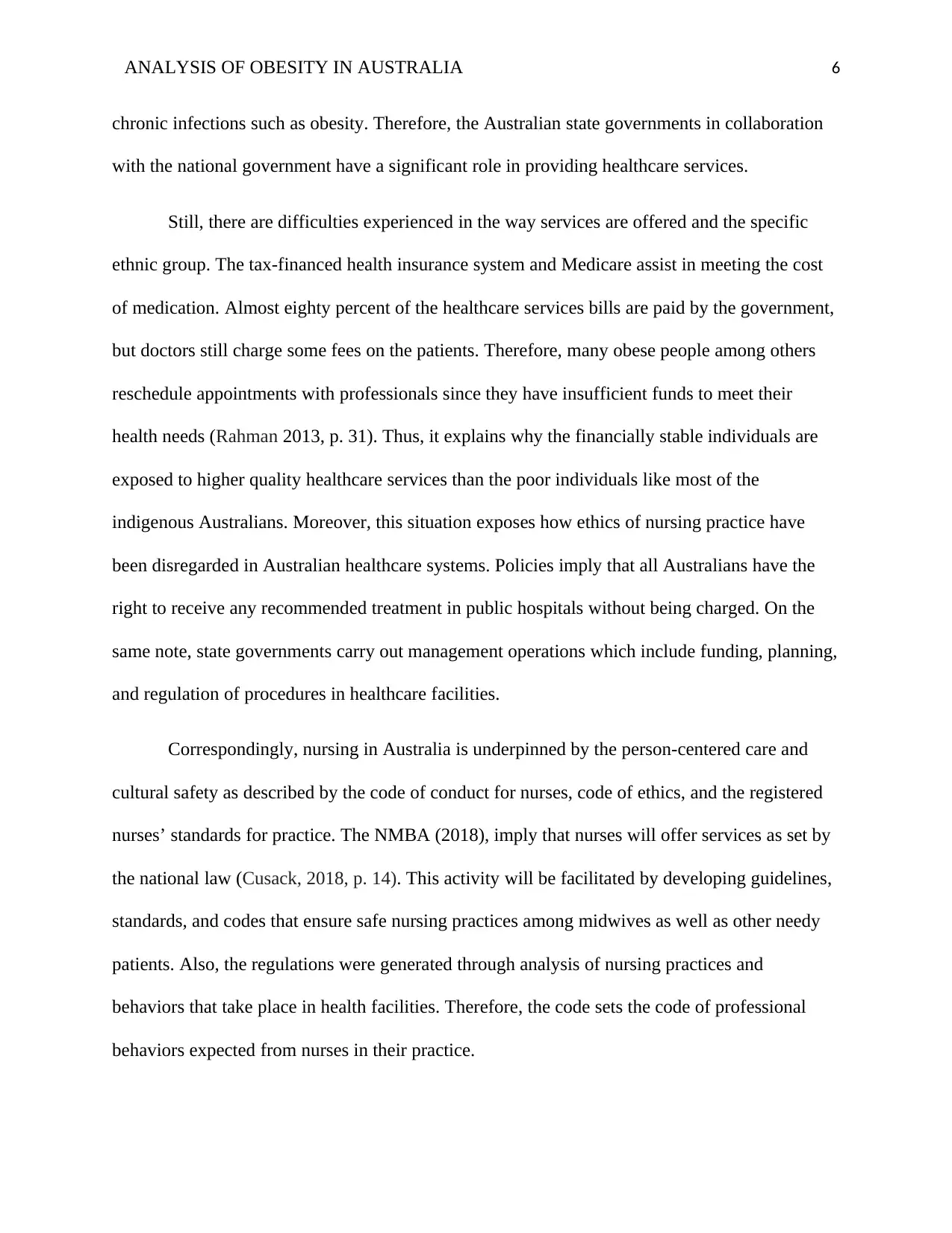
ANALYSIS OF OBESITY IN AUSTRALIA 6
chronic infections such as obesity. Therefore, the Australian state governments in collaboration
with the national government have a significant role in providing healthcare services.
Still, there are difficulties experienced in the way services are offered and the specific
ethnic group. The tax-financed health insurance system and Medicare assist in meeting the cost
of medication. Almost eighty percent of the healthcare services bills are paid by the government,
but doctors still charge some fees on the patients. Therefore, many obese people among others
reschedule appointments with professionals since they have insufficient funds to meet their
health needs (Rahman 2013, p. 31). Thus, it explains why the financially stable individuals are
exposed to higher quality healthcare services than the poor individuals like most of the
indigenous Australians. Moreover, this situation exposes how ethics of nursing practice have
been disregarded in Australian healthcare systems. Policies imply that all Australians have the
right to receive any recommended treatment in public hospitals without being charged. On the
same note, state governments carry out management operations which include funding, planning,
and regulation of procedures in healthcare facilities.
Correspondingly, nursing in Australia is underpinned by the person-centered care and
cultural safety as described by the code of conduct for nurses, code of ethics, and the registered
nurses’ standards for practice. The NMBA (2018), imply that nurses will offer services as set by
the national law (Cusack, 2018, p. 14). This activity will be facilitated by developing guidelines,
standards, and codes that ensure safe nursing practices among midwives as well as other needy
patients. Also, the regulations were generated through analysis of nursing practices and
behaviors that take place in health facilities. Therefore, the code sets the code of professional
behaviors expected from nurses in their practice.
chronic infections such as obesity. Therefore, the Australian state governments in collaboration
with the national government have a significant role in providing healthcare services.
Still, there are difficulties experienced in the way services are offered and the specific
ethnic group. The tax-financed health insurance system and Medicare assist in meeting the cost
of medication. Almost eighty percent of the healthcare services bills are paid by the government,
but doctors still charge some fees on the patients. Therefore, many obese people among others
reschedule appointments with professionals since they have insufficient funds to meet their
health needs (Rahman 2013, p. 31). Thus, it explains why the financially stable individuals are
exposed to higher quality healthcare services than the poor individuals like most of the
indigenous Australians. Moreover, this situation exposes how ethics of nursing practice have
been disregarded in Australian healthcare systems. Policies imply that all Australians have the
right to receive any recommended treatment in public hospitals without being charged. On the
same note, state governments carry out management operations which include funding, planning,
and regulation of procedures in healthcare facilities.
Correspondingly, nursing in Australia is underpinned by the person-centered care and
cultural safety as described by the code of conduct for nurses, code of ethics, and the registered
nurses’ standards for practice. The NMBA (2018), imply that nurses will offer services as set by
the national law (Cusack, 2018, p. 14). This activity will be facilitated by developing guidelines,
standards, and codes that ensure safe nursing practices among midwives as well as other needy
patients. Also, the regulations were generated through analysis of nursing practices and
behaviors that take place in health facilities. Therefore, the code sets the code of professional
behaviors expected from nurses in their practice.
⊘ This is a preview!⊘
Do you want full access?
Subscribe today to unlock all pages.

Trusted by 1+ million students worldwide
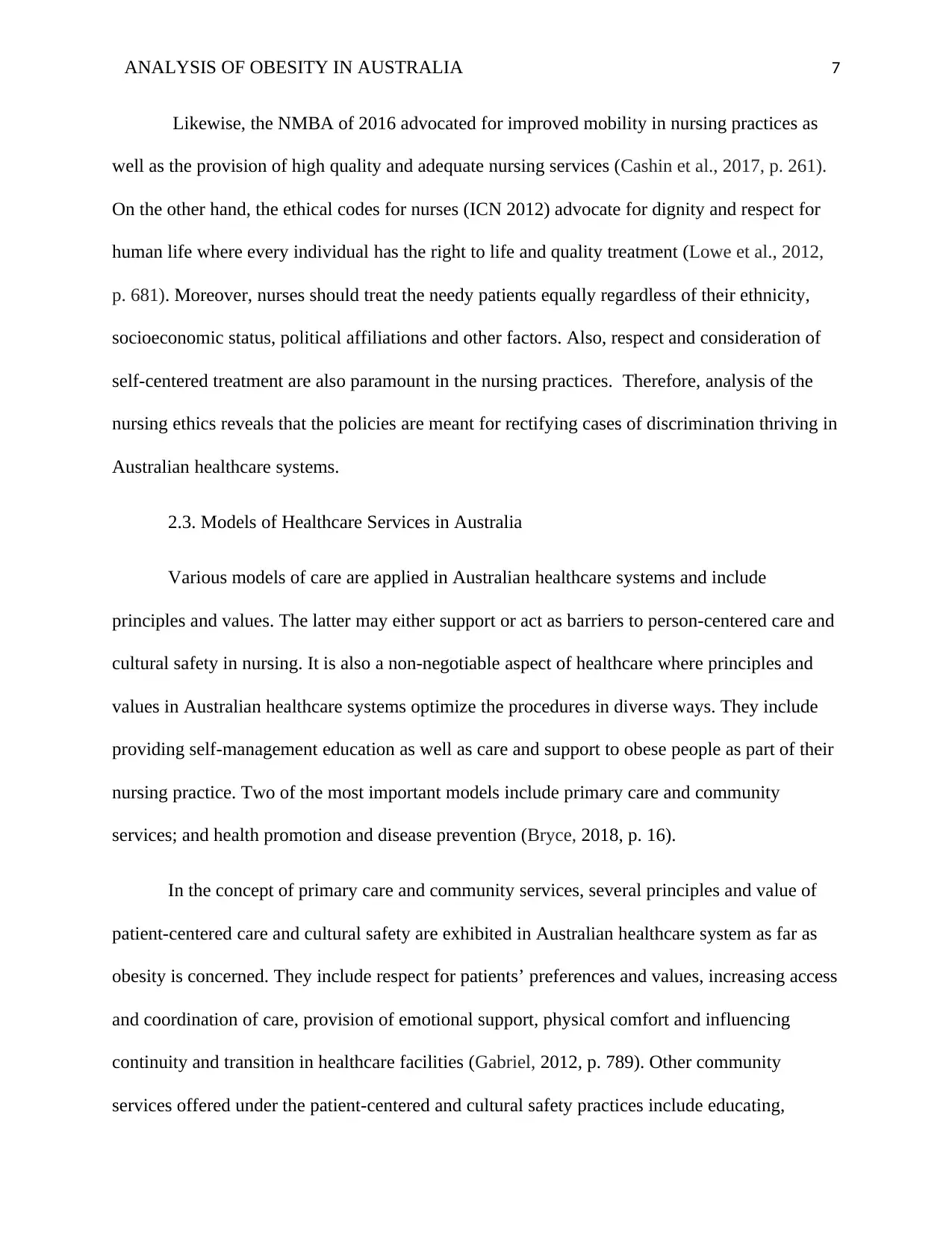
ANALYSIS OF OBESITY IN AUSTRALIA 7
Likewise, the NMBA of 2016 advocated for improved mobility in nursing practices as
well as the provision of high quality and adequate nursing services (Cashin et al., 2017, p. 261).
On the other hand, the ethical codes for nurses (ICN 2012) advocate for dignity and respect for
human life where every individual has the right to life and quality treatment (Lowe et al., 2012,
p. 681). Moreover, nurses should treat the needy patients equally regardless of their ethnicity,
socioeconomic status, political affiliations and other factors. Also, respect and consideration of
self-centered treatment are also paramount in the nursing practices. Therefore, analysis of the
nursing ethics reveals that the policies are meant for rectifying cases of discrimination thriving in
Australian healthcare systems.
2.3. Models of Healthcare Services in Australia
Various models of care are applied in Australian healthcare systems and include
principles and values. The latter may either support or act as barriers to person-centered care and
cultural safety in nursing. It is also a non-negotiable aspect of healthcare where principles and
values in Australian healthcare systems optimize the procedures in diverse ways. They include
providing self-management education as well as care and support to obese people as part of their
nursing practice. Two of the most important models include primary care and community
services; and health promotion and disease prevention (Bryce, 2018, p. 16).
In the concept of primary care and community services, several principles and value of
patient-centered care and cultural safety are exhibited in Australian healthcare system as far as
obesity is concerned. They include respect for patients’ preferences and values, increasing access
and coordination of care, provision of emotional support, physical comfort and influencing
continuity and transition in healthcare facilities (Gabriel, 2012, p. 789). Other community
services offered under the patient-centered and cultural safety practices include educating,
Likewise, the NMBA of 2016 advocated for improved mobility in nursing practices as
well as the provision of high quality and adequate nursing services (Cashin et al., 2017, p. 261).
On the other hand, the ethical codes for nurses (ICN 2012) advocate for dignity and respect for
human life where every individual has the right to life and quality treatment (Lowe et al., 2012,
p. 681). Moreover, nurses should treat the needy patients equally regardless of their ethnicity,
socioeconomic status, political affiliations and other factors. Also, respect and consideration of
self-centered treatment are also paramount in the nursing practices. Therefore, analysis of the
nursing ethics reveals that the policies are meant for rectifying cases of discrimination thriving in
Australian healthcare systems.
2.3. Models of Healthcare Services in Australia
Various models of care are applied in Australian healthcare systems and include
principles and values. The latter may either support or act as barriers to person-centered care and
cultural safety in nursing. It is also a non-negotiable aspect of healthcare where principles and
values in Australian healthcare systems optimize the procedures in diverse ways. They include
providing self-management education as well as care and support to obese people as part of their
nursing practice. Two of the most important models include primary care and community
services; and health promotion and disease prevention (Bryce, 2018, p. 16).
In the concept of primary care and community services, several principles and value of
patient-centered care and cultural safety are exhibited in Australian healthcare system as far as
obesity is concerned. They include respect for patients’ preferences and values, increasing access
and coordination of care, provision of emotional support, physical comfort and influencing
continuity and transition in healthcare facilities (Gabriel, 2012, p. 789). Other community
services offered under the patient-centered and cultural safety practices include educating,
Paraphrase This Document
Need a fresh take? Get an instant paraphrase of this document with our AI Paraphraser
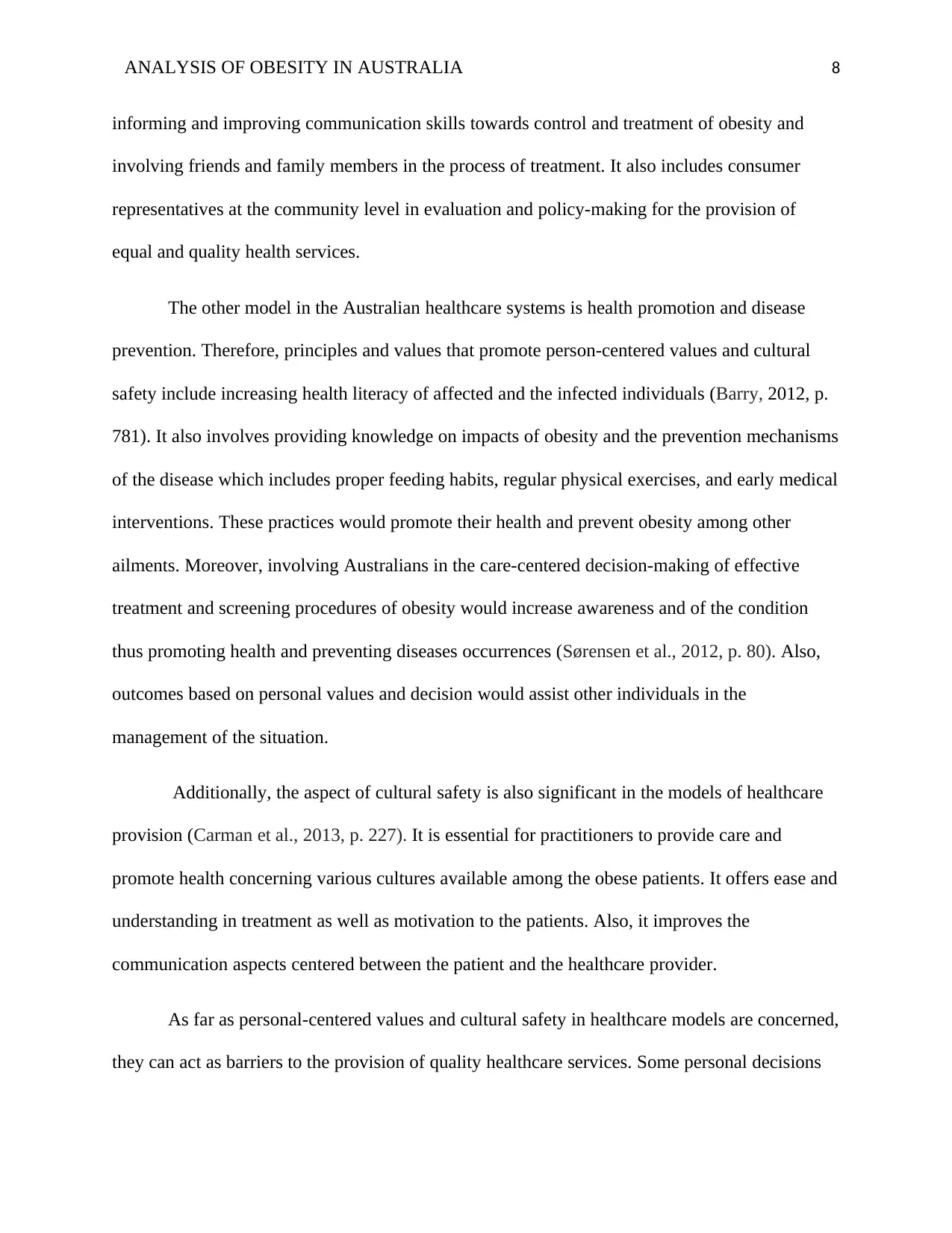
ANALYSIS OF OBESITY IN AUSTRALIA 8
informing and improving communication skills towards control and treatment of obesity and
involving friends and family members in the process of treatment. It also includes consumer
representatives at the community level in evaluation and policy-making for the provision of
equal and quality health services.
The other model in the Australian healthcare systems is health promotion and disease
prevention. Therefore, principles and values that promote person-centered values and cultural
safety include increasing health literacy of affected and the infected individuals (Barry, 2012, p.
781). It also involves providing knowledge on impacts of obesity and the prevention mechanisms
of the disease which includes proper feeding habits, regular physical exercises, and early medical
interventions. These practices would promote their health and prevent obesity among other
ailments. Moreover, involving Australians in the care-centered decision-making of effective
treatment and screening procedures of obesity would increase awareness and of the condition
thus promoting health and preventing diseases occurrences (Sørensen et al., 2012, p. 80). Also,
outcomes based on personal values and decision would assist other individuals in the
management of the situation.
Additionally, the aspect of cultural safety is also significant in the models of healthcare
provision (Carman et al., 2013, p. 227). It is essential for practitioners to provide care and
promote health concerning various cultures available among the obese patients. It offers ease and
understanding in treatment as well as motivation to the patients. Also, it improves the
communication aspects centered between the patient and the healthcare provider.
As far as personal-centered values and cultural safety in healthcare models are concerned,
they can act as barriers to the provision of quality healthcare services. Some personal decisions
informing and improving communication skills towards control and treatment of obesity and
involving friends and family members in the process of treatment. It also includes consumer
representatives at the community level in evaluation and policy-making for the provision of
equal and quality health services.
The other model in the Australian healthcare systems is health promotion and disease
prevention. Therefore, principles and values that promote person-centered values and cultural
safety include increasing health literacy of affected and the infected individuals (Barry, 2012, p.
781). It also involves providing knowledge on impacts of obesity and the prevention mechanisms
of the disease which includes proper feeding habits, regular physical exercises, and early medical
interventions. These practices would promote their health and prevent obesity among other
ailments. Moreover, involving Australians in the care-centered decision-making of effective
treatment and screening procedures of obesity would increase awareness and of the condition
thus promoting health and preventing diseases occurrences (Sørensen et al., 2012, p. 80). Also,
outcomes based on personal values and decision would assist other individuals in the
management of the situation.
Additionally, the aspect of cultural safety is also significant in the models of healthcare
provision (Carman et al., 2013, p. 227). It is essential for practitioners to provide care and
promote health concerning various cultures available among the obese patients. It offers ease and
understanding in treatment as well as motivation to the patients. Also, it improves the
communication aspects centered between the patient and the healthcare provider.
As far as personal-centered values and cultural safety in healthcare models are concerned,
they can act as barriers to the provision of quality healthcare services. Some personal decisions
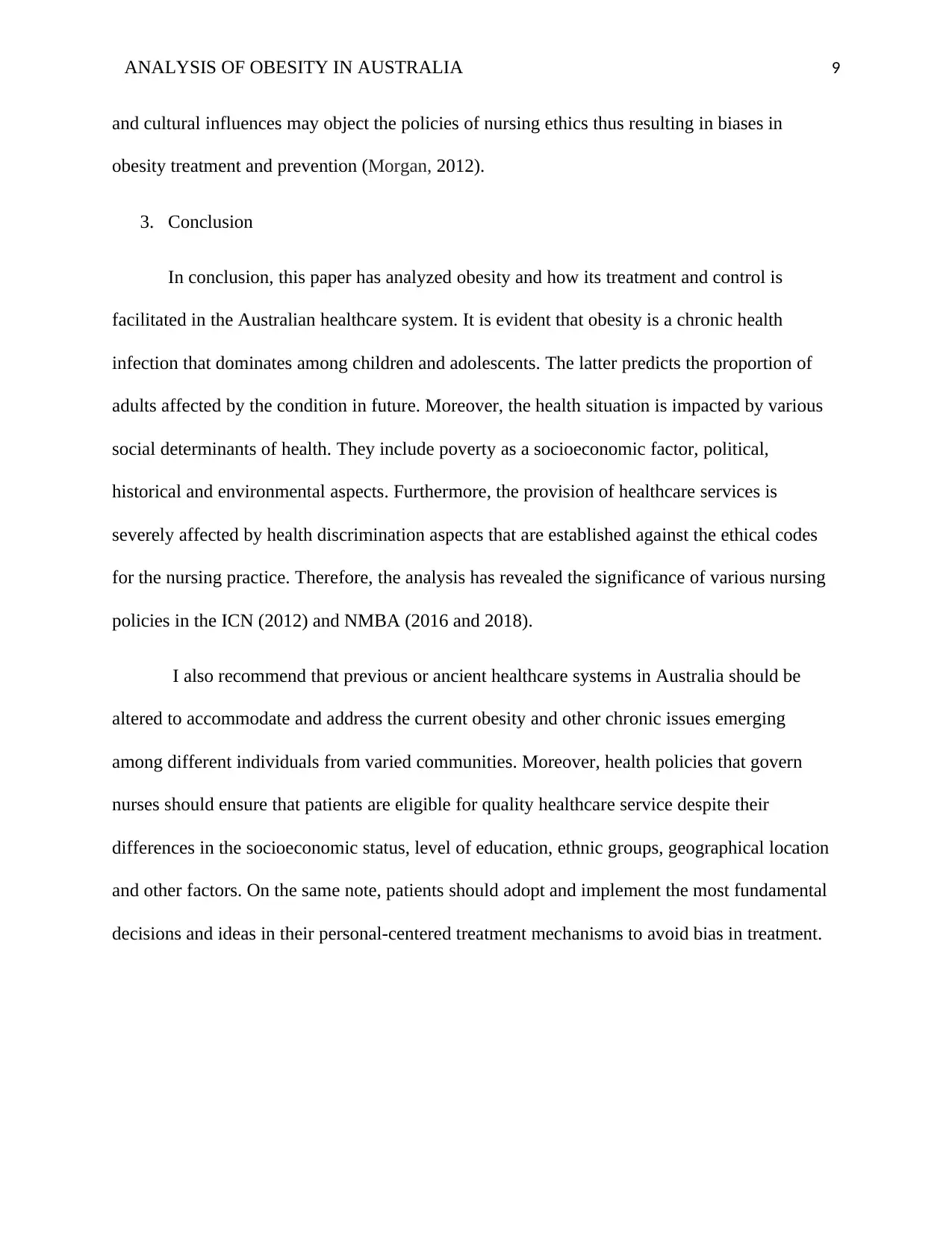
ANALYSIS OF OBESITY IN AUSTRALIA 9
and cultural influences may object the policies of nursing ethics thus resulting in biases in
obesity treatment and prevention (Morgan, 2012).
3. Conclusion
In conclusion, this paper has analyzed obesity and how its treatment and control is
facilitated in the Australian healthcare system. It is evident that obesity is a chronic health
infection that dominates among children and adolescents. The latter predicts the proportion of
adults affected by the condition in future. Moreover, the health situation is impacted by various
social determinants of health. They include poverty as a socioeconomic factor, political,
historical and environmental aspects. Furthermore, the provision of healthcare services is
severely affected by health discrimination aspects that are established against the ethical codes
for the nursing practice. Therefore, the analysis has revealed the significance of various nursing
policies in the ICN (2012) and NMBA (2016 and 2018).
I also recommend that previous or ancient healthcare systems in Australia should be
altered to accommodate and address the current obesity and other chronic issues emerging
among different individuals from varied communities. Moreover, health policies that govern
nurses should ensure that patients are eligible for quality healthcare service despite their
differences in the socioeconomic status, level of education, ethnic groups, geographical location
and other factors. On the same note, patients should adopt and implement the most fundamental
decisions and ideas in their personal-centered treatment mechanisms to avoid bias in treatment.
and cultural influences may object the policies of nursing ethics thus resulting in biases in
obesity treatment and prevention (Morgan, 2012).
3. Conclusion
In conclusion, this paper has analyzed obesity and how its treatment and control is
facilitated in the Australian healthcare system. It is evident that obesity is a chronic health
infection that dominates among children and adolescents. The latter predicts the proportion of
adults affected by the condition in future. Moreover, the health situation is impacted by various
social determinants of health. They include poverty as a socioeconomic factor, political,
historical and environmental aspects. Furthermore, the provision of healthcare services is
severely affected by health discrimination aspects that are established against the ethical codes
for the nursing practice. Therefore, the analysis has revealed the significance of various nursing
policies in the ICN (2012) and NMBA (2016 and 2018).
I also recommend that previous or ancient healthcare systems in Australia should be
altered to accommodate and address the current obesity and other chronic issues emerging
among different individuals from varied communities. Moreover, health policies that govern
nurses should ensure that patients are eligible for quality healthcare service despite their
differences in the socioeconomic status, level of education, ethnic groups, geographical location
and other factors. On the same note, patients should adopt and implement the most fundamental
decisions and ideas in their personal-centered treatment mechanisms to avoid bias in treatment.
⊘ This is a preview!⊘
Do you want full access?
Subscribe today to unlock all pages.

Trusted by 1+ million students worldwide

ANALYSIS OF OBESITY IN AUSTRALIA 10
References
Artuso, S., Cargo, M., Brown, A., & Daniel, M. (2013). Factors influencing health care
utilisation among Aboriginal cardiac patients in central Australia: a qualitative
study. BMC Health Services Research, 13(1), 83.
Badland, H., Whitzman, C., Lowe, M., Davern, M., Aye, L., Butterworth, I., ... & Giles-Corti, B.
(2014). Urban liveability: emerging lessons from Australia for exploring the potential for
indicators to measure the social determinants of health. Social science & medicine, 111,
64-73.
Barry, M. J., & Edgman-Levitan, S. (2012). Shared decision making—the pinnacle of patient-
centered care. New England Journal of Medicine, 366(9), 780-781.
Baum, F. E., Laris, P., Fisher, M., Newman, L., & MacDougall, C. (2013). “Never mind the
logic, give me the numbers”: Former Australian health ministers' perspectives on the
social determinants of health. Social Science & Medicine, 87, 138-146.
Bryce, J., Foley, E., & Reeves, J. (2018). The importance of cultural safety not a
privilege. Australian Nursing and Midwifery Journal, 25(10), 16-16.
Carman, K. L., Dardess, P., Maurer, M., Sofaer, S., Adams, K., Bechtel, C., & Sweeney, J.
(2013). Patient and family engagement: a framework for understanding the elements and
developing interventions and policies. Health Affairs, 32(2), 223-231.
Cashin, A., Heartfield, M., Bryce, J., Devey, L., Buckley, T., Cox, D., ... & Fisher, M. (2017).
Standards for practice for registered nurses in Australia. Collegian, 24(3), 255-266.
References
Artuso, S., Cargo, M., Brown, A., & Daniel, M. (2013). Factors influencing health care
utilisation among Aboriginal cardiac patients in central Australia: a qualitative
study. BMC Health Services Research, 13(1), 83.
Badland, H., Whitzman, C., Lowe, M., Davern, M., Aye, L., Butterworth, I., ... & Giles-Corti, B.
(2014). Urban liveability: emerging lessons from Australia for exploring the potential for
indicators to measure the social determinants of health. Social science & medicine, 111,
64-73.
Barry, M. J., & Edgman-Levitan, S. (2012). Shared decision making—the pinnacle of patient-
centered care. New England Journal of Medicine, 366(9), 780-781.
Baum, F. E., Laris, P., Fisher, M., Newman, L., & MacDougall, C. (2013). “Never mind the
logic, give me the numbers”: Former Australian health ministers' perspectives on the
social determinants of health. Social Science & Medicine, 87, 138-146.
Bryce, J., Foley, E., & Reeves, J. (2018). The importance of cultural safety not a
privilege. Australian Nursing and Midwifery Journal, 25(10), 16-16.
Carman, K. L., Dardess, P., Maurer, M., Sofaer, S., Adams, K., Bechtel, C., & Sweeney, J.
(2013). Patient and family engagement: a framework for understanding the elements and
developing interventions and policies. Health Affairs, 32(2), 223-231.
Cashin, A., Heartfield, M., Bryce, J., Devey, L., Buckley, T., Cox, D., ... & Fisher, M. (2017).
Standards for practice for registered nurses in Australia. Collegian, 24(3), 255-266.
Paraphrase This Document
Need a fresh take? Get an instant paraphrase of this document with our AI Paraphraser

ANALYSIS OF OBESITY IN AUSTRALIA 11
Cusack, L. (2018). Changes to code of conduct and code of ethics new code of conduct for
midwives now in effect for all midwives. Australian Midwifery News, 18(1), 14.
Gabriel, S. E., & Normand, S. L. T. (2012). Getting the methods right—the foundation of
patient-centered outcomes research. New England Journal of Medicine, 367(9), 787-790.
Lowe, G., Plummer, V., O’Brien, A. P., & Boyd, L. (2012). Time to clarify–the value of
advanced practice nursing roles in health care. Journal of advanced nursing, 68(3), 677-
685.
Mitrou, F., Cooke, M., Lawrence, D., Povah, D., Mobilia, E., Guimond, E., & Zubrick, S. R.
(2014). Gaps in Indigenous disadvantage not closing: a census cohort study of social
determinants of health in Australia, Canada, and New Zealand from 1981–2006. BMC
Public Health, 14(1), 201.
Olsson, L. E., Jakobsson Ung, E., Swedberg, K., & Ekman, I. (2013). Efficacy of person‐centred
care as an intervention in controlled trials–a systematic review. Journal of clinical
nursing, 22(3-4), 456-465.
Phelan, S. M., Burgess, D. J., Yeazel, M. W., Hellerstedt, W. L., Griffin, J. M., & Ryn, V. M.
(2015). Impact of weight bias and stigma on quality of care and outcomes for patients
with obesity. Obesity Reviews, 16(4), 319-326.
Rahman, A., & Harding, A. (2013). Prevalence of overweight and obesity epidemic in Australia:
some causes and consequences. JP Journal of Biostatistics, 10(1), 31.
Sav, A., Kendall, E., McMillan, S. S., Kelly, F., Whitty, J. A., King, M. A., & Wheeler, A. J.
(2013). ‘You say treatment, I say hard work’: treatment burden among people with
Cusack, L. (2018). Changes to code of conduct and code of ethics new code of conduct for
midwives now in effect for all midwives. Australian Midwifery News, 18(1), 14.
Gabriel, S. E., & Normand, S. L. T. (2012). Getting the methods right—the foundation of
patient-centered outcomes research. New England Journal of Medicine, 367(9), 787-790.
Lowe, G., Plummer, V., O’Brien, A. P., & Boyd, L. (2012). Time to clarify–the value of
advanced practice nursing roles in health care. Journal of advanced nursing, 68(3), 677-
685.
Mitrou, F., Cooke, M., Lawrence, D., Povah, D., Mobilia, E., Guimond, E., & Zubrick, S. R.
(2014). Gaps in Indigenous disadvantage not closing: a census cohort study of social
determinants of health in Australia, Canada, and New Zealand from 1981–2006. BMC
Public Health, 14(1), 201.
Olsson, L. E., Jakobsson Ung, E., Swedberg, K., & Ekman, I. (2013). Efficacy of person‐centred
care as an intervention in controlled trials–a systematic review. Journal of clinical
nursing, 22(3-4), 456-465.
Phelan, S. M., Burgess, D. J., Yeazel, M. W., Hellerstedt, W. L., Griffin, J. M., & Ryn, V. M.
(2015). Impact of weight bias and stigma on quality of care and outcomes for patients
with obesity. Obesity Reviews, 16(4), 319-326.
Rahman, A., & Harding, A. (2013). Prevalence of overweight and obesity epidemic in Australia:
some causes and consequences. JP Journal of Biostatistics, 10(1), 31.
Sav, A., Kendall, E., McMillan, S. S., Kelly, F., Whitty, J. A., King, M. A., & Wheeler, A. J.
(2013). ‘You say treatment, I say hard work’: treatment burden among people with
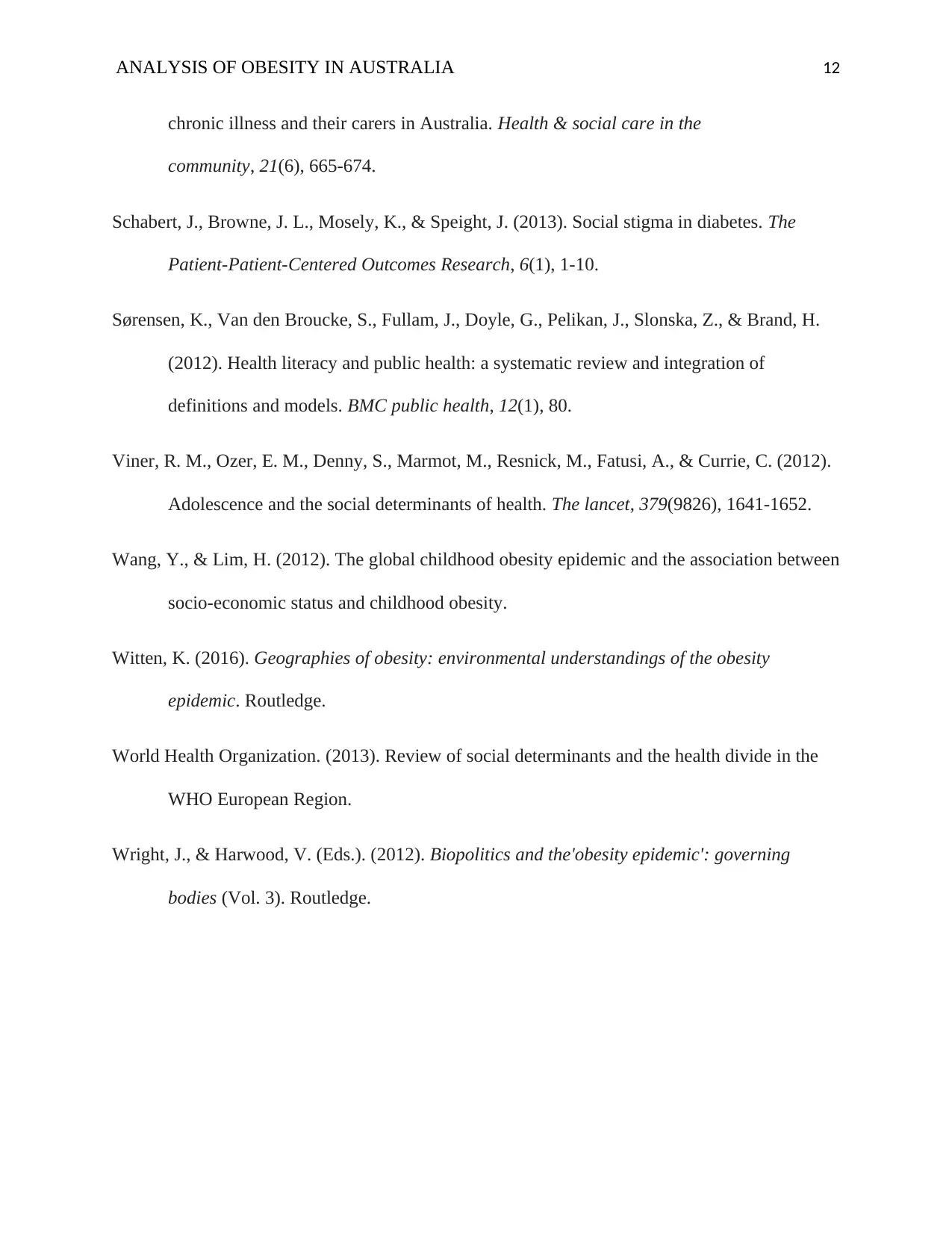
ANALYSIS OF OBESITY IN AUSTRALIA 12
chronic illness and their carers in Australia. Health & social care in the
community, 21(6), 665-674.
Schabert, J., Browne, J. L., Mosely, K., & Speight, J. (2013). Social stigma in diabetes. The
Patient-Patient-Centered Outcomes Research, 6(1), 1-10.
Sørensen, K., Van den Broucke, S., Fullam, J., Doyle, G., Pelikan, J., Slonska, Z., & Brand, H.
(2012). Health literacy and public health: a systematic review and integration of
definitions and models. BMC public health, 12(1), 80.
Viner, R. M., Ozer, E. M., Denny, S., Marmot, M., Resnick, M., Fatusi, A., & Currie, C. (2012).
Adolescence and the social determinants of health. The lancet, 379(9826), 1641-1652.
Wang, Y., & Lim, H. (2012). The global childhood obesity epidemic and the association between
socio-economic status and childhood obesity.
Witten, K. (2016). Geographies of obesity: environmental understandings of the obesity
epidemic. Routledge.
World Health Organization. (2013). Review of social determinants and the health divide in the
WHO European Region.
Wright, J., & Harwood, V. (Eds.). (2012). Biopolitics and the'obesity epidemic': governing
bodies (Vol. 3). Routledge.
chronic illness and their carers in Australia. Health & social care in the
community, 21(6), 665-674.
Schabert, J., Browne, J. L., Mosely, K., & Speight, J. (2013). Social stigma in diabetes. The
Patient-Patient-Centered Outcomes Research, 6(1), 1-10.
Sørensen, K., Van den Broucke, S., Fullam, J., Doyle, G., Pelikan, J., Slonska, Z., & Brand, H.
(2012). Health literacy and public health: a systematic review and integration of
definitions and models. BMC public health, 12(1), 80.
Viner, R. M., Ozer, E. M., Denny, S., Marmot, M., Resnick, M., Fatusi, A., & Currie, C. (2012).
Adolescence and the social determinants of health. The lancet, 379(9826), 1641-1652.
Wang, Y., & Lim, H. (2012). The global childhood obesity epidemic and the association between
socio-economic status and childhood obesity.
Witten, K. (2016). Geographies of obesity: environmental understandings of the obesity
epidemic. Routledge.
World Health Organization. (2013). Review of social determinants and the health divide in the
WHO European Region.
Wright, J., & Harwood, V. (Eds.). (2012). Biopolitics and the'obesity epidemic': governing
bodies (Vol. 3). Routledge.
⊘ This is a preview!⊘
Do you want full access?
Subscribe today to unlock all pages.

Trusted by 1+ million students worldwide
1 out of 12
Related Documents
Your All-in-One AI-Powered Toolkit for Academic Success.
+13062052269
info@desklib.com
Available 24*7 on WhatsApp / Email
![[object Object]](/_next/static/media/star-bottom.7253800d.svg)
Unlock your academic potential
Copyright © 2020–2025 A2Z Services. All Rights Reserved. Developed and managed by ZUCOL.




